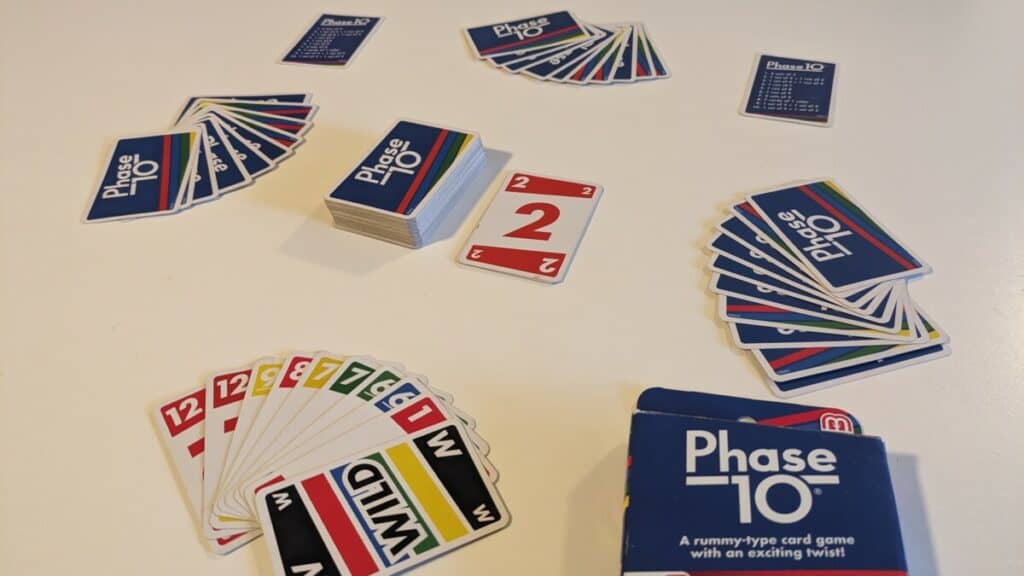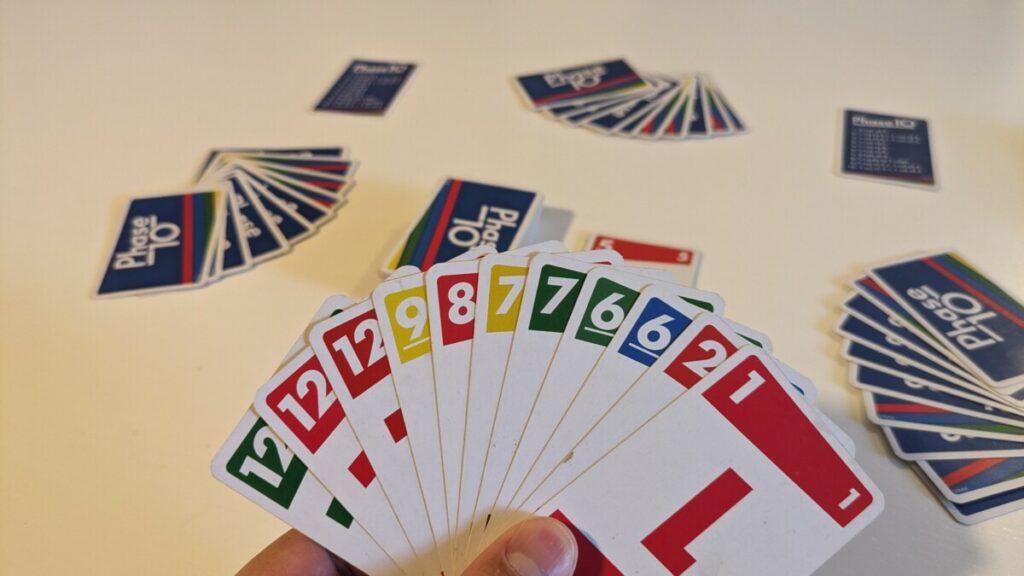
Phase 10 is a classic card game that combines an entertaining mixture of strategy and luck. I’ve been playing Phase 10 (or some version of it) since I was a kid, and I still enjoy playing it with my family and friends. Many players think that the outcome of Phase 10 is purely determined by luck, but I’ve found many strategies that can significantly improve a player’s chances of winning. These Phase 10 strategies will help you enjoy the game more thoroughly and to win more often.
In general, the best Phase 10 strategies are to prioritize making Phases over reducing points, be aware of your opponents’ current Phase, and avoid giving beneficial cards to opponents. More advanced strategies include collecting high-value cards and planning ahead to build off of opponents’ Phases.
Winning at Phase 10 does involve a lot of luck, but if you understand and implement the tips and strategies below you’ll be able to win far more frequently than most. Some of these strategies are more intuitive than others, so I’ll fully explain how and why to use them in your own games so you come out on top more often.
Hold middle cards when your opponent needs a run
When your opponent is on a Phase that requires them to create a long run you should avoid passing any cards in the middle of the number spectrum. There are some cards that (barring Wilds) your opponent absolutely needs to complete their Phase. The longer the run they need, the more cards become essential.
| Run Needed | Necessary Cards |
|---|---|
| 7 | 6, 7 |
| 8 | 5, 6, 7, 8 |
| 9 | 4, 5, 6, 7, 8, 9 |
By passing only cards on the extreme ends of the number spectrum you can frustrate your opponent and force them to draw a random card.
Take note of cards your opponents don’t need
It’s easy to get tunnel-vision in Phase 10, where you are focused only on your own cards and trying to make your Phase. But it’s a competitive game and you have to remember that you’re playing against an opponent who is also trying to build their own hand.
Look at what cards the player to your left is picking up and try to determine what kinds of cards they’re looking for. For example, if their Phase requires two sets and you see them snatch up a ‘3’, you should do your best not to discard any more 3’s.
Play your Phase as early as possible
Phase 10 is all about creating and playing your Phase before other players go out. In some games (including variants and cousins of Phase 10) it can sometimes be smart to delay playing your cards so that opponents have fewer cards to build off of, but this isn’t the case in Phase 10.
CHECK IT OUT: There are a lot of different versions of Phase 10 for sale, but I like this one on Amazon that comes in a hard metal tin. It’s a lot sturdier and easier to transport than the flimsy cardboard boxes that always tear.
The round ends immediately after a player goes out – the rest of the players don’t get one final turn. It’s not worth it to risk missing your Phase simply to deny your opponents the ability to play off of your cards. It’s always best to play your Phase as soon as you have it.
Prioritize Phases over shedding points
A lot of players are fearful of accumulating too many points in Phase 10, but in my experience, this is rarely an issue. Points only matter in the event that two players complete their 10th Phase in the same round, which is fairly uncommon.
It’s much better to focus exclusively on creating your Phases and advancing to the next one than to worry about discarding cards worth more points. Don’t be afraid to hold high-value cards if it gives you a better shot at completing your phase. In fact, sometimes it can be beneficial to hold those cards.

Consider collecting cards worth more points
A common tactic used in Phase 10 is to discard cards that are worth more points since players are afraid of holding them. You can use this to your advantage by collecting high-point cards when you need sets.
If you already have one or two 12’s then it usually pays off to hold them because the player to your right is much more likely to discard a 12 before anything else, all things being equal. It’s worth risking a few more points by holding the 12’s to give you a better shot at advancing your Phase.
Be conscious of your opponents’ current Phase
You should always be aware of what Phase your opponents are in because it can help you predict which cards they need and which they’ll discard. For example, if your opponent is trying to collect cards of one color you can usually determine which color they’re looking for very early on in the round.
Similarly, if your opponent is trying to build a long run of cards then they are more likely to discard cards at either end of the number spectrum. In this case, if you’re trying to build a set of numbers then it might be best to favor keeping cards that are either very high or very low.
Plan ahead to build off of your opponents
One of the hardest parts of Phase 10 is getting rid of the rest of your cards after you’ve created your Phase. This is done via ‘hitting’, where you play off of sets and runs that have already been played by you or other players.
While playing a round of Phase 10 you should make it a secondary goal (your primary goal should always be completing your Phase) to prepare to ‘go out’. If your opponents have already played their phases or if you have an idea of what they might play in the future you should try to tailor your hand so that once you’ve played your Phase you can ‘hit’ and go out as soon as possible.
For example, if an opponent is on the ‘7 cards of one color’ phase you will likely be able to tell which color they’re going for. If you save cards of that color in your own hand then once they play their Phase you’ll be able to play off of it, helping you to win the round.
Use Skip Cards to target winning players

The use of Skip Cards can be very powerful in Phase 10. Many players think that a Skip Card can only skip the player to their left, but the rules state that you can pick which player gets skipped on their next turn. If a player is on a Phase ahead of you then it’s usually best to target them with your Skip Cards so that they are less likely to advance to the next Phase, allowing you to catch up.
A secondary benefit of the Skip Card is that the player with the next turn can’t draw it from the discard pile, meaning they are forced to draw a random card. If two consecutive opponents are on the same Phase then you should play the Skip Card on the player that would play first (closest to your left). This skips that player’s turn and then also denies the second player the ability to draw from the discard pile.
Discard high-value cards after your Phase
After you have played your Phase your new primary goal should be to get rid of as many cards as possible. All else being equal, you should prioritize playing or discarding as many high-value cards as possible.
If you still happen to have any Wild Cards in your hand then you should play then as soon as possible so that you aren’t stuck with all of those points (25 each). Always discard a Skip Card if you have it to hinder your opponents and to ensure you don’t take those points (15 points). Then, prioritize playing or discarding 10s, 11s, and 12s which are worth 10 points each.
Thanks for reading! If I missed something or you have your own opinions, please drop a comment below.
What is thr benefit of along out first in hand? Seems to me like you would never want to assume…
Your strategy comments are excellent, well thought out and very helpful! Thank you
You would only get to draw and play a Sanctuary card on turn two of round one if the Region…
Rule question. If in phase one of round one I play a Region card with a Clue symbol at the…

Leave a Reply